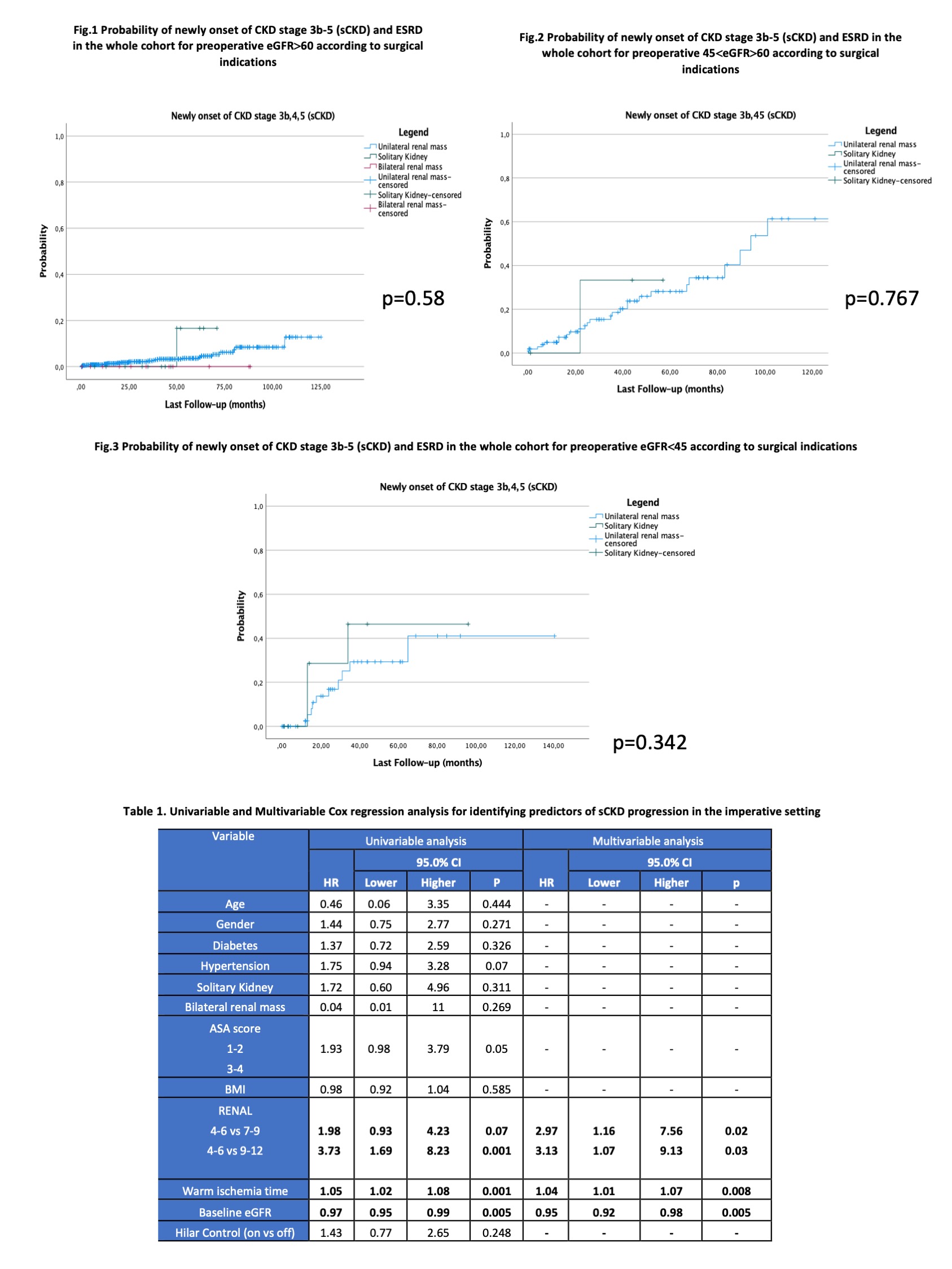Back
Poster, Podium & Video Sessions
Moderated Poster
MP24: Kidney Cancer: Localized: Surgical Therapy I
MP24-12: Risks assessment of significant renal function deterioration after partial nephrectomy and call for reconsidering the imperative setting
Saturday, May 14, 2022
8:45 AM – 10:00 AM
Location: Room 222
Umberto Anceschi*, Rome, Italy, Andrea Minervini, Andrea Mari, Antonio Andrea Grosso, Florence , Italy, Cristian Fiori, Francesco Porpiglia, Orbassano, Turin, Italy, Gabriele Tuderti, Alfredo Maria Bove, Aldo Brassetti, Leonardo Misuraca, Riccardo Mastroianni, Mariaconsiglia Ferriero, Rome, Italy, Daniele Amparore, Orbassano , Italy, Riccardo Autorino, Richmond, VA, Alessandro Veccia, Brescia , Italy, Chandru Sundaram, Indianapolis , IN, Daniel Eun, Philadelphia, IN, Jennifer Lee, Philadelphia, PA, Ithaar Derweesh, San Diego , CA, Umberto Capitanio, Alessandro Larcher, Francesco Montorsi, Milan , Italy, Michele Gallucci, Giuseppe Simone, Rome, Italy

Umberto Anceschi
IRCCS "Regina Elena" National Cancer Institute
Poster Presenter(s)
Introduction: In this multicentric studies we assessed the differences in risk of progression to significant chronic kidney disease (sCKD) following minimally-invasive (MI) PN in patients with solitary kidney or bilateral tumors compared with the standard cohort of PN after stratifying for baseline renal function.
Methods: Data were retrospectively collected into a collaborative minimally-invasive renal surgery dataset (n=2218) of patients treated with MIPN between 2007 and 2021. Kaplan-Meier analysis was computed to analyze the risk of progression to sCKD in solitary kidneys vs bilateral tumors vs standard population and subsequently the analysis was performed after stratifying for baseline estimated Glomerular Filtration Rate (eGFR). Cox regression analyses were performed to identify predictors of progression to sCKD (stages =3b). For all statistical analyses, a two-sided p < 0.05 was considered significant.
Results: Overall, 33 patients had tumors in solitary kidneys and 107 had bilateral renal tumors. At Kaplan Meier analysis, patients with bilateral tumors and solitary kidneys displayed risks of progression to sCKD comparable to those of patients who underwent elective (baseline eGFR >60 mL/min) MIPN (Fig.1a, p=0.58). In the setting of “imperative” MIPN (baseline eGFR <60 ml/min) similar risks were displayed either with baseline stage 3a CKD (Fig 1b, p=0.76) or with baseline stage 3b CKD ( Fig 1c, p=0.34). In the subcohort of patients with baseline eGFR <60 ml/min (344 patients), at multivariable Cox regression analysis, RENAL score³9 (HR 3.1; 95% CI 1.07-9.13; p=0.03) warm ischemia time (HR 1.04; 95% CI 1.01-1.07; p=0.008) and baseline eGFR (HR 0.95; 95% CI 0.92-0.98; p=0.005) were independent predictors of sCKD
Conclusions: The risks of developing renal function deterioration in patients with tumors harbouring in solitary kidneys and in those with bilateral renal tumors are comparable to the whole PN population. When planning a PN in patients with baseline renal function impairment ( <60 mL/min), once taken into account baseline eGFR and anatomic tumor complexity as unmodifiable variables, efforts to minimize ischemia time may turn into significant benefits on long term functional outcomes.
Source of Funding: None

Methods: Data were retrospectively collected into a collaborative minimally-invasive renal surgery dataset (n=2218) of patients treated with MIPN between 2007 and 2021. Kaplan-Meier analysis was computed to analyze the risk of progression to sCKD in solitary kidneys vs bilateral tumors vs standard population and subsequently the analysis was performed after stratifying for baseline estimated Glomerular Filtration Rate (eGFR). Cox regression analyses were performed to identify predictors of progression to sCKD (stages =3b). For all statistical analyses, a two-sided p < 0.05 was considered significant.
Results: Overall, 33 patients had tumors in solitary kidneys and 107 had bilateral renal tumors. At Kaplan Meier analysis, patients with bilateral tumors and solitary kidneys displayed risks of progression to sCKD comparable to those of patients who underwent elective (baseline eGFR >60 mL/min) MIPN (Fig.1a, p=0.58). In the setting of “imperative” MIPN (baseline eGFR <60 ml/min) similar risks were displayed either with baseline stage 3a CKD (Fig 1b, p=0.76) or with baseline stage 3b CKD ( Fig 1c, p=0.34). In the subcohort of patients with baseline eGFR <60 ml/min (344 patients), at multivariable Cox regression analysis, RENAL score³9 (HR 3.1; 95% CI 1.07-9.13; p=0.03) warm ischemia time (HR 1.04; 95% CI 1.01-1.07; p=0.008) and baseline eGFR (HR 0.95; 95% CI 0.92-0.98; p=0.005) were independent predictors of sCKD
Conclusions: The risks of developing renal function deterioration in patients with tumors harbouring in solitary kidneys and in those with bilateral renal tumors are comparable to the whole PN population. When planning a PN in patients with baseline renal function impairment ( <60 mL/min), once taken into account baseline eGFR and anatomic tumor complexity as unmodifiable variables, efforts to minimize ischemia time may turn into significant benefits on long term functional outcomes.
Source of Funding: None


.jpg)
.jpg)